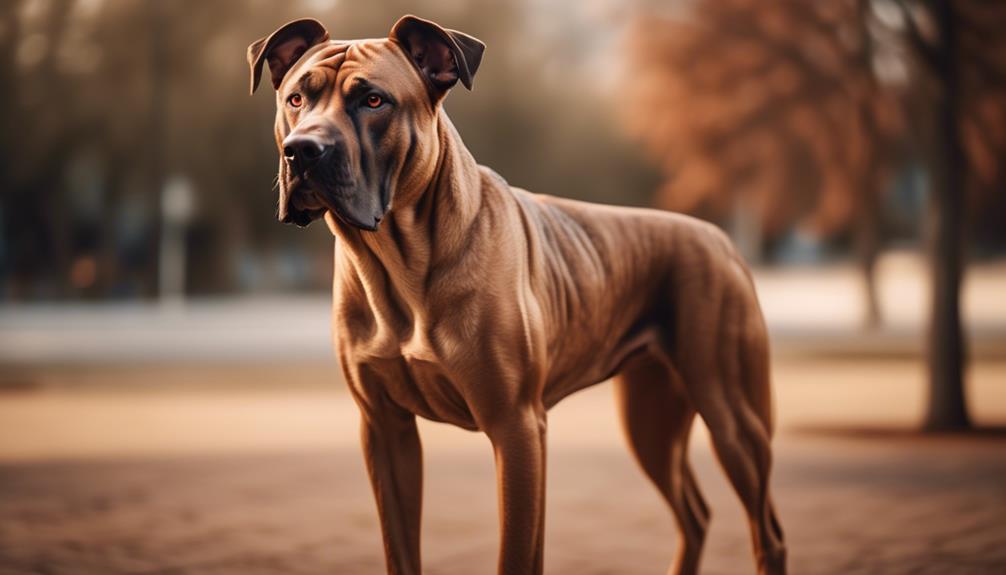
Have you ever wondered what makes the Tosa dog breed so unique? With its origins in Japan and a history rooted in dog fighting, the Tosa has a fascinating story to tell.
But did you know that this breed, known for its imposing presence and loyalty, can also adapt well to different living environments? Whether you live in an apartment or a house, the Tosa has the potential to be your perfect companion.
But there’s much more to discover about this breed, from its physical characteristics to its temperament and health care needs. So, are you ready to uncover the secrets of the Tosa dog breed?
Key Takeaways
- The Tosa dog breed originated in Japan and was developed for dog fighting.
- They are large in size, with a height of 25-28 inches and weight ranging from 130-200 pounds.
- Tosa dogs have a short, smooth coat and come in various colors such as brindle, red, fawn, or black.
- They are known for being reserved, loyal, protective, and intelligent, but require high exercise needs.
Origins and History of the Tosa Dog Breed
The Tosa dog breed, also known as Tosa Ken or the Japanese Fighting Dog, has a fascinating origins and history. Originated in Japan in the 19th century, it was specifically developed for dog fighting. To create a larger and more powerful dog, the Tosa was crossbred with European breeds.
Between 1924 and 1933, the Tosa became immensely popular in Japan. It gained recognition and was known by various names. The Tosa is a large breed, standing at 25-28 inches tall and weighing between 130-200 pounds. With a short and smooth coat, it comes in brindle, red, fawn, or black colors.
The Tosa is known for its reserved temperament, loyalty, protectiveness, and intelligence. It requires high levels of exercise and adapts well to apartment living.
See another Dog breed profile.
Toy Fox Terrier Breed
Development and Purpose of Tosa Dogs
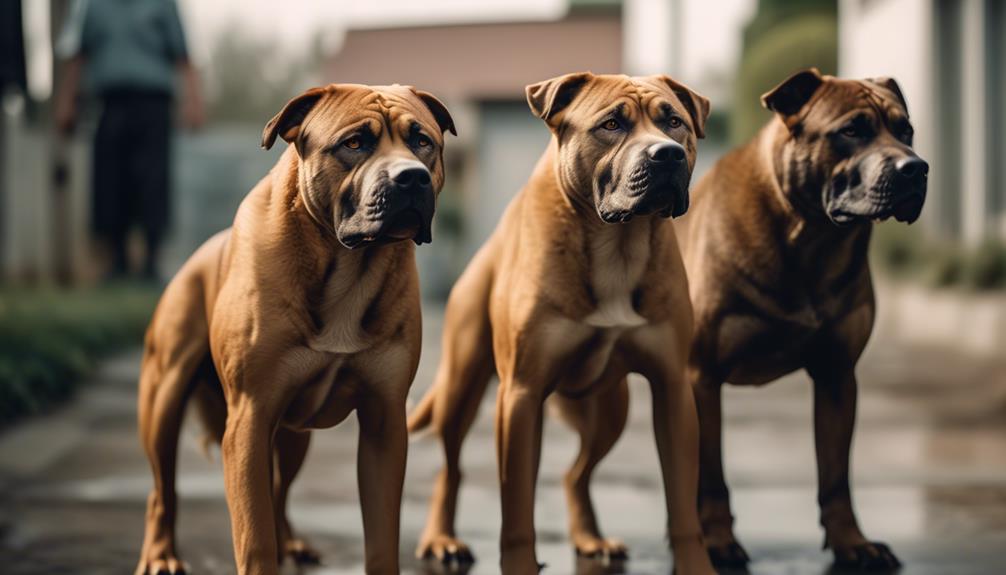
To understand the development and purpose of Tosa dogs, it’s important to delve into their historical context and the intentions behind their creation.
- Bred for dog fighting: Tosa dogs were specifically developed for the purpose of dog fighting in Japan during the 19th century.
- Crossbred with European breeds: In order to create a larger and more powerful dog, Tosa dogs were crossbred with European breeds such as Bulldogs, Mastiffs, and German Pointers.
- Popular between 1924 and 1933: Tosa dogs gained significant popularity in Japan during this time period, and were even featured in national dog fighting tournaments.
These development choices were made with the intention of creating a strong and formidable dog that excelled in the sport of dog fighting.
However, it’s important to note that dog fighting is illegal and inhumane in many countries today, and the Tosa breed should be appreciated for its other qualities such as loyalty, intelligence, and protectiveness.
Various Names for the Tosa Dog Breed

Also known as the Tosa Ken and Japanese Fighting Dog, the Tosa breed has gained recognition under various names throughout its history. These names highlight the breed’s origins and purpose.
In Japan, it’s referred to as the Tosa Inu, which translates to ‘Tosa dog.’ The name ‘Japanese Fighting Dog’ accurately describes its historical role in dog fighting competitions. In some regions, it’s also known as the Tosa Tōken, emphasizing its strength and power.
Regardless of the name, the Tosa breed is renowned for its size, loyalty, and protective nature. These names not only reflect the breed’s heritage but also capture its unique characteristics that make it a remarkable and formidable dog.
Size and Physical Characteristics of Tosa Dogs
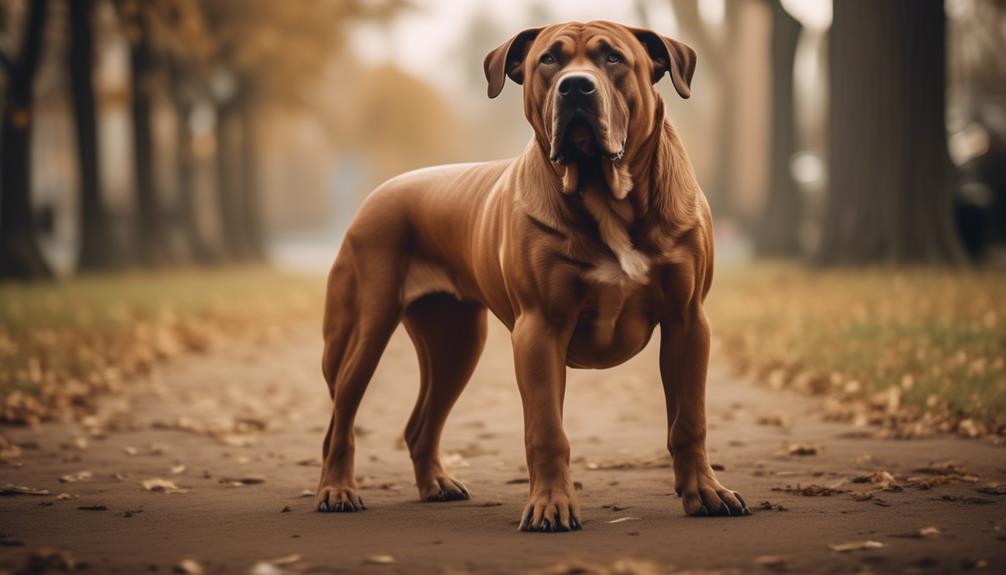
With their large size and distinct physical characteristics, Tosa dogs are easily recognizable and stand out among other breeds. Here are some key features that define their appearance:
- Massive Build: Tosa dogs have a robust and muscular body, giving them a powerful and imposing presence.
- Broad Head: They’ve a broad and strong head with a deep muzzle and strong jaws.
- Thick Neck: Their neck is thick and well-muscled, adding to their overall strength.
These physical characteristics contribute to their impressive stature and make them well-suited for their original purpose as fighting dogs. However, it’s important to note that Tosa dogs are also known for their gentle and loyal nature, making them suitable companions for experienced and responsible owners.
Lifespan and Health of Tosa Dogs
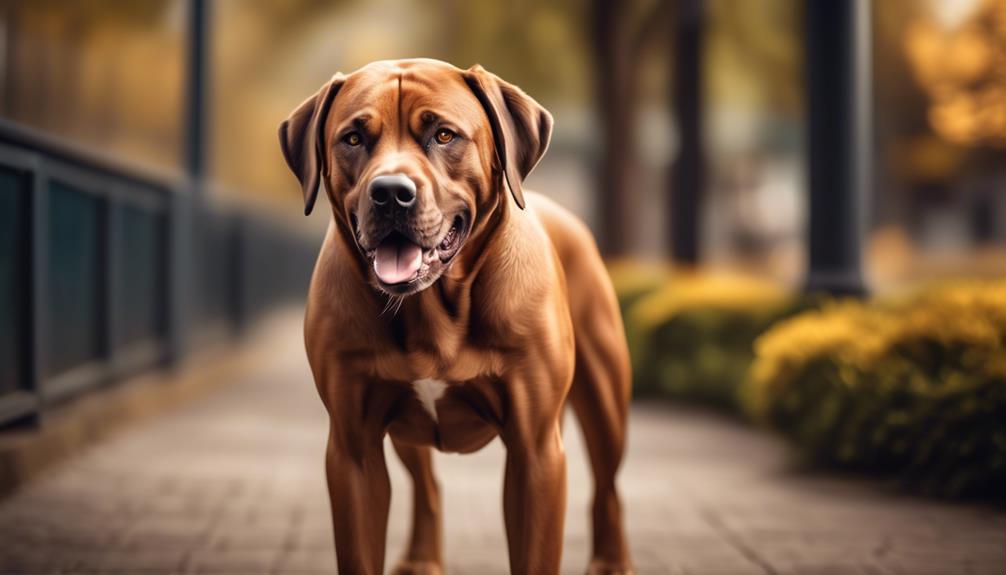
What is the average lifespan and overall health of Tosa dogs?
Tosa dogs have an average lifespan of 10 to 12 years. However, it’s important to note that individual dogs may vary in health and longevity.
Like many large breeds, Tosa dogs are prone to certain health conditions. These include bloat, hip dysplasia, and eye problems. To ensure their well-being, it’s crucial to provide them with ample outdoor time and regular exercise. Additionally, proper dental hygiene and nail care are important aspects of their overall health. Tosa dogs should be fed a diet specifically formulated for large breeds with high energy levels.
Although they’re affectionate with their families, their protective nature and fighting instincts make them unsuitable for households with small children. Early socialization efforts contribute to their overall well-being.
Coat Types and Colors of Tosa Dogs
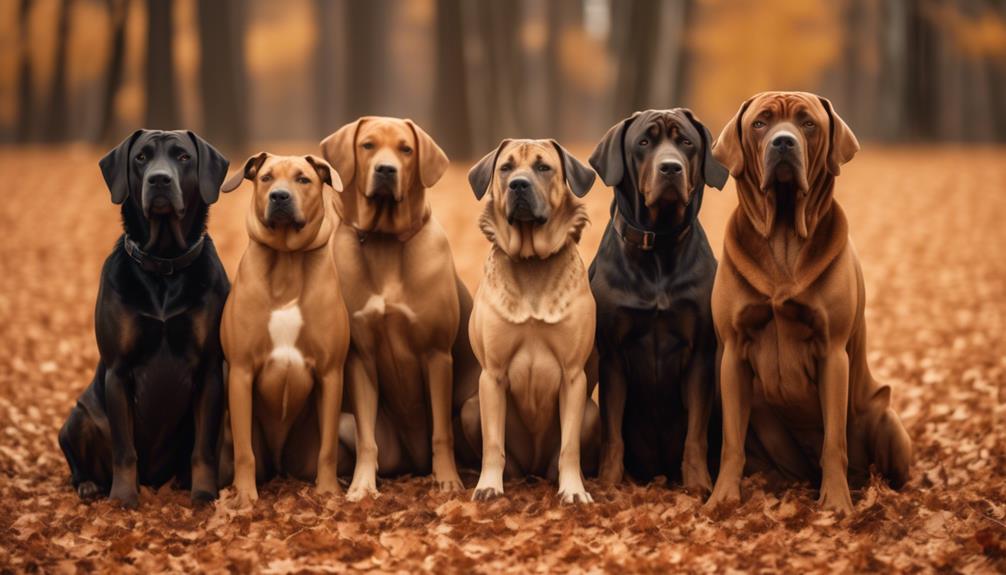
To further explore the characteristics of Tosa dogs, let’s now turn our attention to their distinct coat types and colors.
Tosa dogs have three primary coat colors:
- Brindle: This coat color is characterized by a base color, usually fawn or red, with dark stripes running across the body. The brindle pattern can vary in intensity, creating unique and striking markings.
- Red: Tosa dogs with a red coat have a rich, deep reddish color that can range from a lighter shade to a darker, more mahogany hue. This solid color creates a sleek and elegant appearance.
- Fawn: Tosa dogs with a fawn coat have a light tan or beige color that gives them a warm and gentle look. The fawn color can vary in shade, ranging from a pale cream to a deeper tan.
The coat types of Tosa dogs are generally short and smooth, which requires minimal grooming and maintenance.
Temperament and Personality Traits of Tosa Dogs
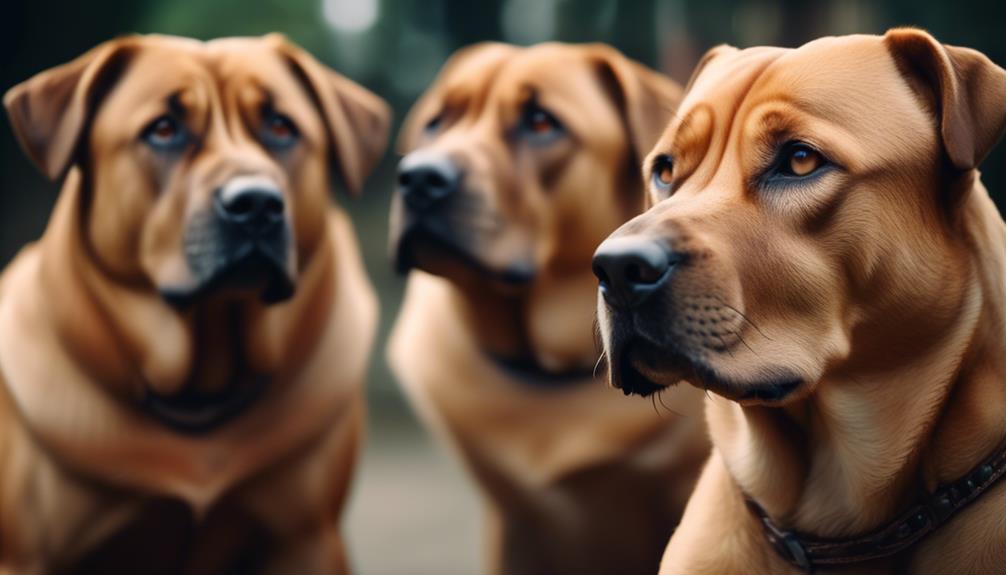
Tosa dogs are known for their reserved yet loyal temperament and possessive nature. They’re highly devoted to their families and exhibit great loyalty towards them.
These dogs can be aloof and reserved with strangers, but with proper socialization, they can learn to be more accepting. Tosa dogs are protective by nature and have a strong guarding instinct, which makes them excellent watchdogs.
It’s important to note that their possessive nature can sometimes lead to aggression, so early training and socialization are crucial. Despite their size and protective nature, Tosa dogs are generally gentle and affectionate with their family members.
They thrive on human companionship and make loyal and loving pets when properly trained and socialized.
Exercise Needs and Activity Level of Tosa Dogs

Tosa dogs require regular exercise and have a high activity level to maintain their physical and mental well-being. To keep your Tosa dog happy and healthy, consider the following:
- Daily walks: Take your Tosa for brisk walks at least twice a day to help burn off their excess energy.
- Active playtime: Engage in interactive games like fetch or tug-of-war to stimulate their mind and keep them physically active.
- Mental stimulation: Provide puzzle toys or treat-dispensing toys to challenge their intelligence and prevent boredom.
Adaptability of Tosa Dogs to Different Living Environments

Living in various environments, the Tosa dog demonstrates remarkable adaptability. Whether you live in a spacious house or a small apartment, this breed can easily adjust to different living conditions. Consider the following factors when deciding if a Tosa dog is suitable for your living environment:
| Living Environment | Adaptability |
|---|---|
| Apartment | Tosa dogs can adapt well to apartment living, as long as their exercise needs are met. Consider your neighbors when selecting a dog and opt for quiet and low-energy breeds. Some small breeds can also thrive in apartments. Polite behavior towards other residents is important. |
| House with Yard | Tosa dogs are well-suited for houses with yards, as they require ample outdoor time and exercise. They enjoy having space to roam and play. However, ensure that your yard is securely fenced to prevent them from wandering off. |
No matter where you live, the Tosa dog’s adaptability allows them to thrive in various living environments. Just make sure to meet their exercise needs and provide a suitable space for them to live happily.
Friendliness of Tosa Dogs Towards Family and Strangers
When it comes to the friendliness of Tosa dogs towards family and strangers, they’re known to be affectionate and loyal companions. Here are three key characteristics to consider:
- Devoted and loving: Tosa dogs form strong bonds with their families and are incredibly loyal. They’ll go above and beyond to protect and care for their loved ones.
- Reserved with strangers: Due to their protective nature, Tosa dogs may be reserved when meeting new people. Early socialization is crucial to ensure they’re comfortable and well-behaved in various social situations.
- Protective instincts: Tosa dogs have a natural instinct to protect their family members and their territory. While this can be a positive trait, it’s important to provide proper training and guidance to ensure their protective instincts are channeled appropriately.
Health Care and Special Considerations for Tosa Dogs

As you continue to explore the world of Tosa dogs, it’s essential to address their health care and unique considerations.
Tosa dogs are prone to specific health conditions such as bloat, hip dysplasia, and eye problems. To ensure their well-being, ample outdoor time and exercise are necessary. It’s also important to maintain their dental hygiene and take care of their nails. Tosa dogs require a diet formulated for large breeds with high energy levels.
Their common coat colors are red, fawn, and occasionally black. Due to their protective nature and fighting instincts, Tosa dogs aren’t suitable for households with small children. Early socialization efforts are highly beneficial, and it’s important to note that Tosa breed-specific rescues may be limited.
Taking these considerations into account will help you provide the best possible care for your Tosa dog.
Frequently Asked Questions
Are Tosa Dogs Good With Children?
Tosa dogs may not be suitable for households with small children due to their protective nature and fighting instincts. Early socialization efforts are highly beneficial to help them adapt to children.
How Much Exercise Does a Tosa Dog Need?
A Tosa dog needs a high amount of exercise. They are large dogs with a lot of energy, so daily walks, playtime, and mental stimulation are essential to keep them happy and healthy.
What Are the Grooming Requirements for a Tosa Dog?
To keep a Tosa dog’s coat looking its best, regular grooming is essential. Brush their short, smooth fur to remove loose hair and prevent matting. Don’t forget about dental hygiene and nail care too!
Are Tosa Dogs Prone to Any Specific Health Issues?
Yes, Tosa dogs are prone to specific health issues such as bloat, hip dysplasia, and eye problems. It’s important to provide ample outdoor time and exercise, maintain dental hygiene, and feed them a diet formulated for large breeds with high energy levels.
Can Tosa Dogs Be Left Alone for Long Periods of Time?
Tosa dogs should not be left alone for long periods of time. They are loyal and protective, and being alone for extended periods can lead to behavioral issues. They thrive on human companionship and need regular exercise and mental stimulation.
Conclusion
In conclusion, the Tosa dog breed is a loyal and protective companion that can adapt well to different living environments. With its large size and impressive physical characteristics, the Tosa is an imposing presence.
It requires high levels of exercise and early socialization is crucial for its temperament.
Overall, if you’re looking for a loyal and intelligent dog breed, the Tosa might be the perfect choice for you.




